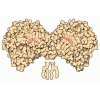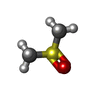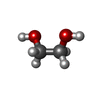[English] 日本語
 Yorodumi
Yorodumi- PDB-7a21: Crystal structure of the ACVR1 (ALK2) kinase in complex with the ... -
+ Open data
Open data
- Basic information
Basic information
| Entry | Database: PDB / ID: 7a21 | ||||||
|---|---|---|---|---|---|---|---|
| Title | Crystal structure of the ACVR1 (ALK2) kinase in complex with the compound M4K2158 | ||||||
 Components Components | Activin receptor type I | ||||||
 Keywords Keywords | SIGNALING PROTEIN / Kinase / inhibitor complex / receptor / BMP | ||||||
| Function / homology |  Function and homology information Function and homology informationendocardial cushion cell fate commitment / mitral valve morphogenesis / BMP receptor complex / cardiac muscle cell fate commitment / BMP receptor activity / atrial septum primum morphogenesis / endocardial cushion fusion / positive regulation of cardiac epithelial to mesenchymal transition / acute inflammatory response / positive regulation of determination of dorsal identity ...endocardial cushion cell fate commitment / mitral valve morphogenesis / BMP receptor complex / cardiac muscle cell fate commitment / BMP receptor activity / atrial septum primum morphogenesis / endocardial cushion fusion / positive regulation of cardiac epithelial to mesenchymal transition / acute inflammatory response / positive regulation of determination of dorsal identity / transforming growth factor beta receptor activity, type I / smooth muscle cell differentiation / activin receptor complex / activin receptor activity, type I / endocardial cushion formation / pharyngeal system development / transmembrane receptor protein serine/threonine kinase activity / receptor protein serine/threonine kinase / activin binding / cellular response to BMP stimulus / activin receptor signaling pathway / negative regulation of activin receptor signaling pathway / embryonic heart tube morphogenesis / gastrulation with mouth forming second / dorsal/ventral pattern formation / transforming growth factor beta binding / determination of left/right symmetry / atrioventricular valve morphogenesis / neural crest cell migration / branching involved in blood vessel morphogenesis / ventricular septum morphogenesis / negative regulation of G1/S transition of mitotic cell cycle / SMAD binding / germ cell development / peptide hormone binding / positive regulation of intracellular signal transduction / mesoderm formation / positive regulation of SMAD protein signal transduction / regulation of ossification / positive regulation of bone mineralization / positive regulation of osteoblast differentiation / negative regulation of signal transduction / BMP signaling pathway / transforming growth factor beta receptor signaling pathway / protein tyrosine kinase binding / negative regulation of extrinsic apoptotic signaling pathway / cellular response to growth factor stimulus / apical part of cell / osteoblast differentiation / heart development / in utero embryonic development / cell differentiation / protein kinase activity / positive regulation of cell migration / cadherin binding / protein serine/threonine kinase activity / positive regulation of DNA-templated transcription / protein homodimerization activity / positive regulation of transcription by RNA polymerase II / ATP binding / metal ion binding / plasma membrane Similarity search - Function | ||||||
| Biological species |  Homo sapiens (human) Homo sapiens (human) | ||||||
| Method |  X-RAY DIFFRACTION / X-RAY DIFFRACTION /  SYNCHROTRON / SYNCHROTRON /  MOLECULAR REPLACEMENT / Resolution: 2.14 Å MOLECULAR REPLACEMENT / Resolution: 2.14 Å | ||||||
 Authors Authors | Adamson, R.J. / Williams, E.P. / Smil, D. / Burgess-Brown, N. / von Delft, F. / Arrowsmith, C.H. / Edwards, A.M. / Bountra, C. / Bullock, A.N. | ||||||
 Citation Citation |  Journal: To Be Published Journal: To Be PublishedTitle: Crystal structure of the ACVR1 (ALK2) kinase in complex with the compound M4K2153 Authors: Adamson, R.J. / Williams, E.P. / Smil, D. / Burgess-Brown, N. / von Delft, F. / Arrowsmith, C.H. / Edwards, A.M. / Bountra, C. / Bullock, A.N. | ||||||
| History |
|
- Structure visualization
Structure visualization
| Structure viewer | Molecule:  Molmil Molmil Jmol/JSmol Jmol/JSmol |
|---|
- Downloads & links
Downloads & links
- Download
Download
| PDBx/mmCIF format |  7a21.cif.gz 7a21.cif.gz | 136.9 KB | Display |  PDBx/mmCIF format PDBx/mmCIF format |
|---|---|---|---|---|
| PDB format |  pdb7a21.ent.gz pdb7a21.ent.gz | 105.7 KB | Display |  PDB format PDB format |
| PDBx/mmJSON format |  7a21.json.gz 7a21.json.gz | Tree view |  PDBx/mmJSON format PDBx/mmJSON format | |
| Others |  Other downloads Other downloads |
-Validation report
| Summary document |  7a21_validation.pdf.gz 7a21_validation.pdf.gz | 887 KB | Display |  wwPDB validaton report wwPDB validaton report |
|---|---|---|---|---|
| Full document |  7a21_full_validation.pdf.gz 7a21_full_validation.pdf.gz | 897.9 KB | Display | |
| Data in XML |  7a21_validation.xml.gz 7a21_validation.xml.gz | 25.5 KB | Display | |
| Data in CIF |  7a21_validation.cif.gz 7a21_validation.cif.gz | 34.5 KB | Display | |
| Arichive directory |  https://data.pdbj.org/pub/pdb/validation_reports/a2/7a21 https://data.pdbj.org/pub/pdb/validation_reports/a2/7a21 ftp://data.pdbj.org/pub/pdb/validation_reports/a2/7a21 ftp://data.pdbj.org/pub/pdb/validation_reports/a2/7a21 | HTTPS FTP |
-Related structure data
| Related structure data | 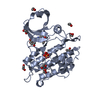 3mtfS S: Starting model for refinement |
|---|---|
| Similar structure data |
- Links
Links
- Assembly
Assembly
| Deposited unit | 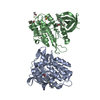
| ||||||||||
|---|---|---|---|---|---|---|---|---|---|---|---|
| 1 | 
| ||||||||||
| 2 | 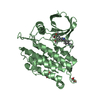
| ||||||||||
| Unit cell |
|
- Components
Components
| #1: Protein | Mass: 34537.633 Da / Num. of mol.: 2 / Mutation: Q207D Source method: isolated from a genetically manipulated source Details: No special compound details. / Source: (gene. exp.)  Homo sapiens (human) / Gene: ACVR1 / Cell line (production host): Sf9 / Production host: Homo sapiens (human) / Gene: ACVR1 / Cell line (production host): Sf9 / Production host:  References: UniProt: Q04771, receptor protein serine/threonine kinase #2: Chemical | #3: Chemical | #4: Chemical | #5: Water | ChemComp-HOH / | Has ligand of interest | Y | |
|---|
-Experimental details
-Experiment
| Experiment | Method:  X-RAY DIFFRACTION / Number of used crystals: 1 X-RAY DIFFRACTION / Number of used crystals: 1 |
|---|
- Sample preparation
Sample preparation
| Crystal | Density Matthews: 2.65 Å3/Da / Density % sol: 53.65 % |
|---|---|
| Crystal grow | Temperature: 293 K / Method: vapor diffusion, sitting drop / pH: 7.4 Details: 16% PEG8K, 15% glycerol, 0.08M potassium phosphate dibasic |
-Data collection
| Diffraction | Mean temperature: 100 K / Serial crystal experiment: N |
|---|---|
| Diffraction source | Source:  SYNCHROTRON / Site: SYNCHROTRON / Site:  Diamond Diamond  / Beamline: I04 / Wavelength: 0.97949 Å / Beamline: I04 / Wavelength: 0.97949 Å |
| Detector | Type: ADSC QUANTUM 315 / Detector: CCD / Date: Dec 8, 2018 / Details: Compound Refractive Lenses |
| Radiation | Monochromator: double crystal / Protocol: SINGLE WAVELENGTH / Monochromatic (M) / Laue (L): M / Scattering type: x-ray |
| Radiation wavelength | Wavelength: 0.97949 Å / Relative weight: 1 |
| Reflection | Resolution: 2.14→46.09 Å / Num. obs: 39523 / % possible obs: 99.9 % / Observed criterion σ(I): 1.5 / Redundancy: 6.6 % / Biso Wilson estimate: 33.17 Å2 / CC1/2: 0.99 / Rmerge(I) obs: 0.253 / Rpim(I) all: 0.107 / Rrim(I) all: 0.275 / Χ2: 0.98 / Net I/σ(I): 5.3 |
| Reflection shell | Resolution: 2.14→2.2 Å / Redundancy: 6.4 % / Rmerge(I) obs: 1.747 / Mean I/σ(I) obs: 1 / Num. unique obs: 2862 / CC1/2: 0.542 / Rpim(I) all: 0.937 / Rrim(I) all: 1.901 / Χ2: 0.86 / % possible all: 99.9 |
- Processing
Processing
| Software |
| |||||||||||||||||||||||||||||||||||||||||||||||||||||||||||||||||||||||||||||||||||||||||||||||||||||||||
|---|---|---|---|---|---|---|---|---|---|---|---|---|---|---|---|---|---|---|---|---|---|---|---|---|---|---|---|---|---|---|---|---|---|---|---|---|---|---|---|---|---|---|---|---|---|---|---|---|---|---|---|---|---|---|---|---|---|---|---|---|---|---|---|---|---|---|---|---|---|---|---|---|---|---|---|---|---|---|---|---|---|---|---|---|---|---|---|---|---|---|---|---|---|---|---|---|---|---|---|---|---|---|---|---|---|---|
| Refinement | Method to determine structure:  MOLECULAR REPLACEMENT MOLECULAR REPLACEMENTStarting model: 3MTF Resolution: 2.14→46.09 Å / SU ML: 0.33 / Cross valid method: THROUGHOUT / σ(F): 1.34 / Phase error: 29.25 / Stereochemistry target values: ML
| |||||||||||||||||||||||||||||||||||||||||||||||||||||||||||||||||||||||||||||||||||||||||||||||||||||||||
| Solvent computation | Shrinkage radii: 0.9 Å / VDW probe radii: 1.11 Å / Solvent model: FLAT BULK SOLVENT MODEL | |||||||||||||||||||||||||||||||||||||||||||||||||||||||||||||||||||||||||||||||||||||||||||||||||||||||||
| Displacement parameters | Biso max: 103.75 Å2 / Biso mean: 37.704 Å2 / Biso min: 18.68 Å2 | |||||||||||||||||||||||||||||||||||||||||||||||||||||||||||||||||||||||||||||||||||||||||||||||||||||||||
| Refinement step | Cycle: final / Resolution: 2.14→46.09 Å
| |||||||||||||||||||||||||||||||||||||||||||||||||||||||||||||||||||||||||||||||||||||||||||||||||||||||||
| LS refinement shell | Refine-ID: X-RAY DIFFRACTION / Rfactor Rfree error: 0 / Total num. of bins used: 14
|
 Movie
Movie Controller
Controller



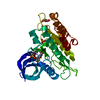

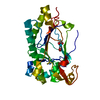
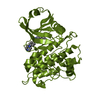
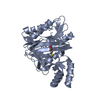
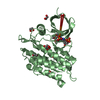

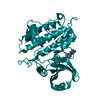

 PDBj
PDBj